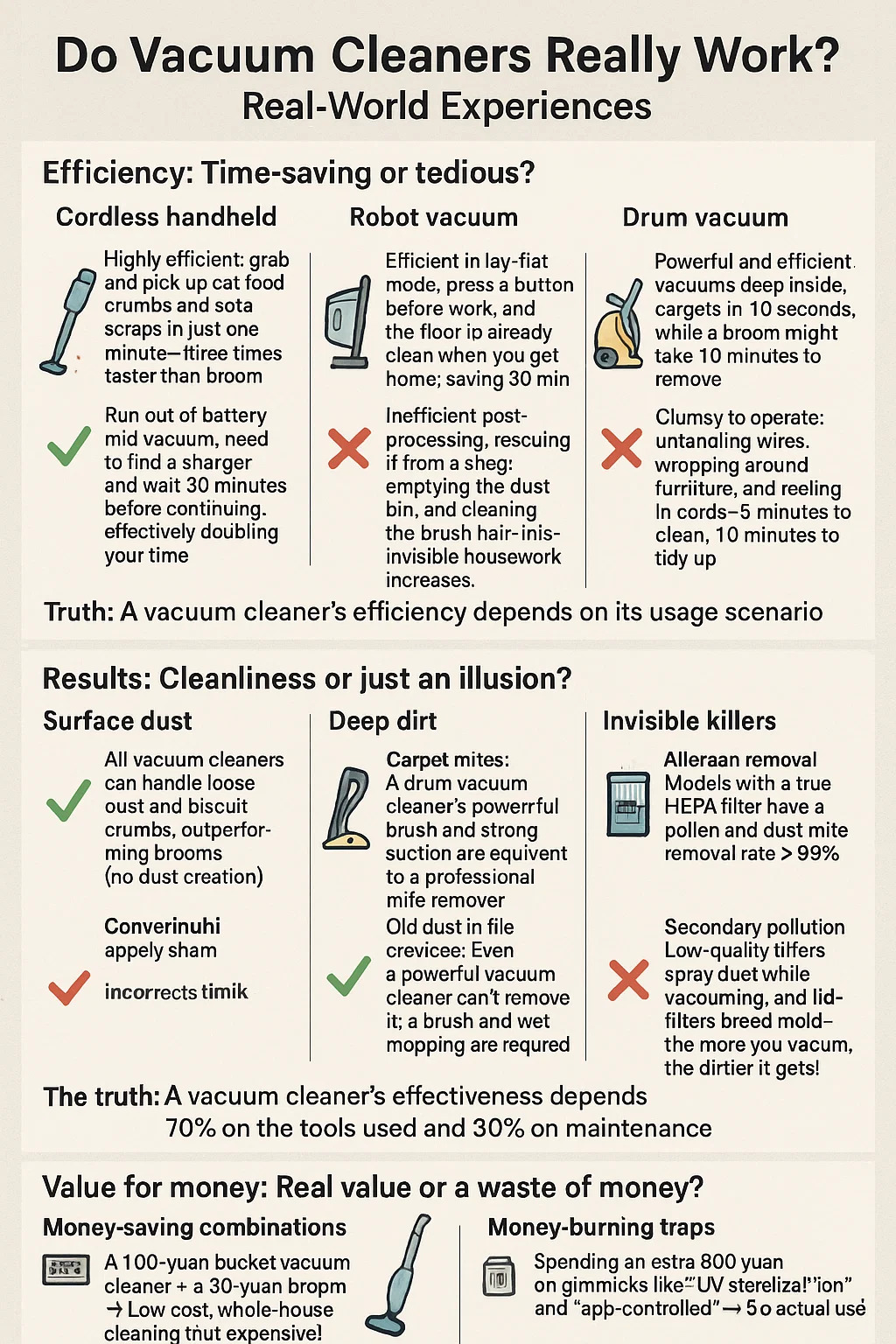Do vacuum cleaners really work? Real-world experiences.
1. Efficiency: Time-saving or tedious?
Cordless handhelds: Highly efficient: Grab and pick up cat food crumbs and sofa scraps in just one minute—three times faster than a broom. Efficiency pitfall: Run out of battery mid-vacuum, need to find a charger and wait 30 minutes before continuing, effectively doubling your time.
Robot vacuums: Efficient in lay-flat mode: Press a button before work, and the floor is already clean when you get home, saving 30 minutes daily. Inefficient post-processing: Rescuing it from a snag (like getting stuck on the scale), emptying the dust bin, and cleaning the brush hair—invisible housework increases.
Drum vacuums: Powerful and efficient: Vacuums deep inside carpets in 10 seconds, while a broom might take 10 minutes to remove. Clumsy to operate: Untangling wires, wrapping around furniture, and reeling in cords—5 minutes to clean, 10 minutes to tidy up. The truth: A vacuum cleaner's efficiency depends on its usage scenario.
Sudden small stains ► Cordless vacuum cleaners are more efficient
Maintaining daily cleanliness ► Vacuum cleaners are more efficient
Monthly cleaning ► Drum vacuum cleaners are more efficient
2. Results: Cleanliness or just an illusion?
Surface dust: All vacuum cleaners can handle loose dust and biscuit crumbs, outperforming brooms (no dust creation).
Deep dirt: Carpet mites: A drum vacuum cleaner's powerful brush and strong suction are equivalent to a professional mite remover. Old dust in tile crevices: Even a powerful vacuum cleaner can't remove it; a brush and wet mopping are required.
Invisible killers: Allergen removal: Models with a true HEPA filter have a pollen and dust mite removal rate of >99%. Secondary pollution: Low-quality filters spray dust while vacuuming, and dirty filters breed mold—the more you vacuum, the dirtier it gets!
The truth: A vacuum cleaner's effectiveness depends 70% on the tools used and 30% on maintenance.
A vacuum cleaner with a hole in the filter is a dust agitator.
A vacuum cleaner that doesn't trim hair from its brush is an allergen seeder.
3. Value for money: Real value or a waste of money?
Money-saving combinations: ► A 100-yuan bucket vacuum cleaner + a 30-yuan broom → Low-cost, whole-house cleaning (but expensive). ► A 1,000-yuan vacuum cleaner + monthly cleaning fee savings → 2-year payback (ideal for lazy people).
Money-burning traps: ► Spending an extra 800 yuan on gimmicks like "UV sterilization" and "app-controlled" → ≈ 0 actual use. ► A high-end cordless vacuum cleaner costs 600 yuan to replace its battery after 3 years → Better to just buy a new one.
The truth: Whether a vacuum cleaner is worth it depends on two calculations:
Money: Price divided by expected lifespan (10 years for a bucket vacuum cleaner > 5 years for a cordless vacuum cleaner).
Effort: Maintenance time + learning cost (older people are discouraged from setting up and debugging robots).


 English
English 中文简体
中文简体










